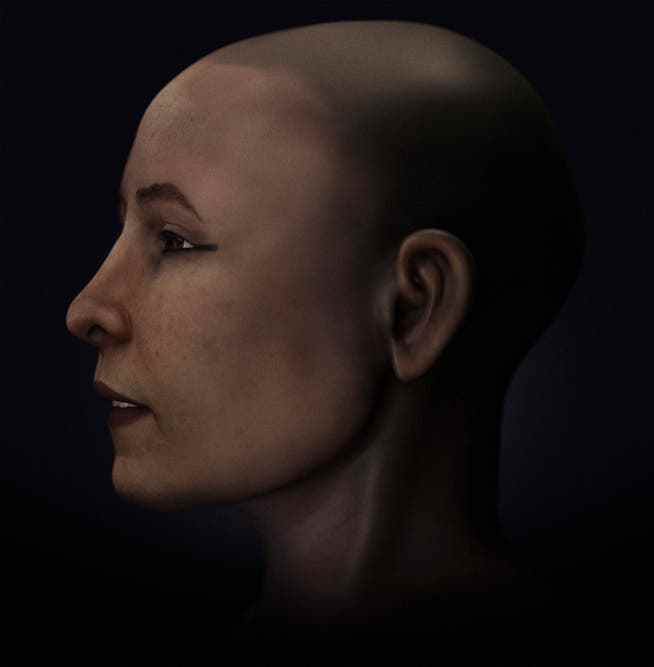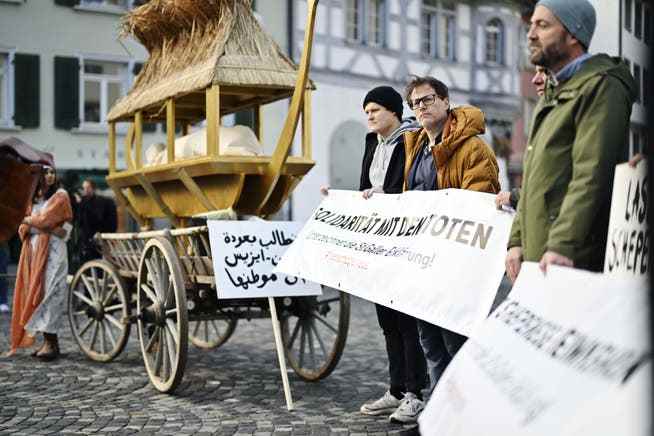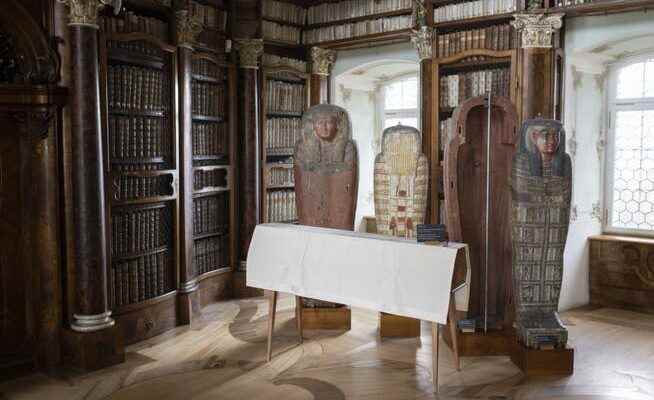From St. Gallen back to Egypt – that is the route Schepenese, mummy and main attraction of the St. Gallen Abbey Library, is supposed to take. At least according to Milo Rau.
The covered Schepenese mummy, photographed on Thursday, November 17, 2022, in the Abbey Library in St. Gallen.
The sun is shining in St. Gallen and the face of theater man Milo Rau is beaming. A little perhaps because it was awarded the city’s culture prize. But mainly because of what he intends to do with it. The 30,000 francs in prize money are intended to help Rau write the last chapter in a thousand-year history.
It is the story of an Egyptian woman who was born on the banks of the Nile sometime between 650 and 610 BC. Her father, the Amun priest Pestjenef, named his child in honor of her grandmother Schepenese – a gift from Isis. The girl grows up in the city that Homer calls “Thebes with a Hundred Gates” in his “Iliad”.
First act: death
Schepenese dies at the age of just over thirty. Her family has her mummified: the intestines are removed through a small incision in the groin, and the brain is pulled through the nose with a hook. A sarcophagus is made and Shepenese is most likely laid to rest in the Hathor Chapel on the south side of the Temple of Hatshepsut – in present-day Luxor.
This is where Schepenese’s story could end. If she had to, find Milo Rau and his allies. This includes “celebrities from science, culture and politics such as Adolf Muschg, Sibylle Berg, Bénédicte Savoy, Gesine Krüger, Peter Stamm, Jean Ziegler and Kim de l’Horizon”, as Rau writes in a press release. Rau summoned them all because he wants to influence Schepenese’s future. In fact, Schepenese’s life was only the first of three acts in her story.

An attempt was made to reconstruct Schepenese’s face using a CT scan. This is what the Egyptian woman who died about 2600 years ago might have looked like.
Time act: robbery?
Schepenese lay in her grave, embalmed and forgotten, for about 2400 years. Then their final rest is disturbed. When and how could not be finally clarified despite great efforts. Was it grave robbers? scientist?
What is certain is that Napoleon’s landing in Egypt in 1798 also awakened interest in this country’s advanced civilization. French, English and later also German scientists open graves, marvel at the treasures and even more so at the sarcophagi. They finally decipher the hieroglyphs and carry numerous artefacts to Europe. Even grave robbers realize that a lot of money can be made with the relics. They plunder final resting places and sell the mummies with their sarcophagi and grave goods across the sea to Europe, where an Egyptian fever has long been raging.
In 1820 Schepenese, embedded in her two sarcophagi, also went this way and came to St. Gallen. The then Landammann Karl von Müller-Friedberg bought it from the German businessman Philipp Roux or even got it as a gift from him. Schepenese was the first of its kind in Switzerland and was loaned to the St. Gallen Abbey Library, where it has remained the most important attraction to this day.
Third Act: Return?
Because you can’t change history, but improve it, as Monica Hanna said in St. Gallen, you’re now standing on Gallusplatz on Thursday afternoon. Hanna is an Egyptologist and Professor of Cultural Heritage at the University of Aswan. And she wants to bring Schepenese home. In doing so, she and Rau Schepenese are leading to a discussion that has been going on for a long time. About how to deal with foreign cultural assets. And whether human remains should be on display.

When parts of the St. Gallen Declaration are read that are particularly important to director Milo Rau (yellow jacket), he nods seriously.
Because Rau is someone who makes theatre, his demand is staged theatrically. He has set up a wooden chariot with a barge on which rests a fully covered imitation of Shepenese’s mummy. He has announced a ritual for the afternoon that will set the stage for his «St. Gallen Declaration». In this he demands that everyone involved, including the Abbey Library, work together to find a way to return the St. Gallen mummy to its Egyptian place of origin by the end of 2023.
Because: “There is no scientific reason why a mummy should be shown in a medieval library. Schepenese is really just a curiosity, a scary thing,” says writer Peter Stamm, who supports the explanation.
In addition to rethinking Schepenese, the St. Gallen declaration also calls on the city to introduce a “franc of dignity”: a franc that goes into a Schepenese fund from every ticket sold to the abbey library, with which “cultural exchange and debates » should be promoted.
Schepenese drives through the city
Like a large accordion, the wagon with the false Schepenese, from which music sounds from a box, pulls past the “House of Truth”, the cheese dairy and Credit Suisse and under the Christmas lights that have already been installed. He rattles across a zebra crossing and is stopped by the police. You talk briefly, explain yourself quickly, give the police officer – and all onlookers – a printed “St. Gallen Declaration» and is allowed to pass.
The wagon moves towards Lokremise, where Rau is officially awarded the prize, the yield of which he has already promised. There will also be a panel discussion with Rau, Hanna and Cornel Dora, head of the Abbey Library. The latter is not very enthusiastic about the matter. Schepenese belongs in the Abbey Library. Not least because St. Gallen connects a sad story with the probable burial site of Schepenese: on November 17, 1997, exactly 25 years ago, 62 people were killed in the Luxor assassination attempt in Hatshepsut’s temple – more than half from Switzerland, among them also four St. Gallen – their lives. Schepenese, who was most likely buried in this very temple, also represents a place of remembrance for these people, explains Dora.
Peter Stamm counters this: “You can also simply ask yourself whether you would approve of your body being exhibited at some point so that people can get the creeps.”
“Good night, Shepenese”
However, Dora doesn’t rule out the possibility that the pride of the St. Gallen Abbey Library will return to Egypt, not only because of the emotional connection. An Egyptian museum or even an Egyptian authority would have to ask for this, “but we have not received any request so far”. Dora is convinced that there is no interest in the mummy in Egypt. There are already enough mummies and sarcophagi there – and they are often not taken care of as much as they are in St. Gallen.
It was also important to the ancient Egyptians to let their dead rest in a place where they would be treated with respect and where there was a meaningful connection for them. This can be found in St. Gallen, where the mummy has a beautiful burial space. And where she is covered with a “Good night, Schepenese” every evening.
